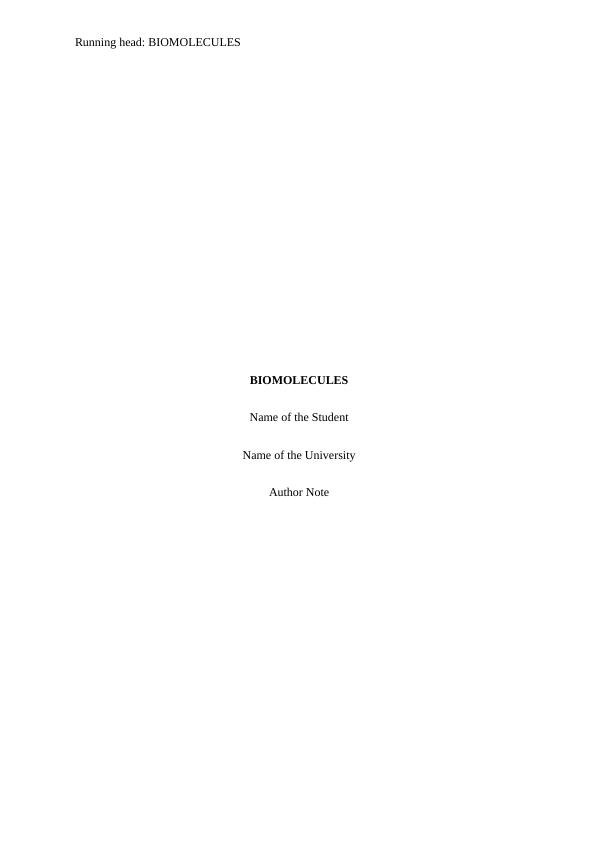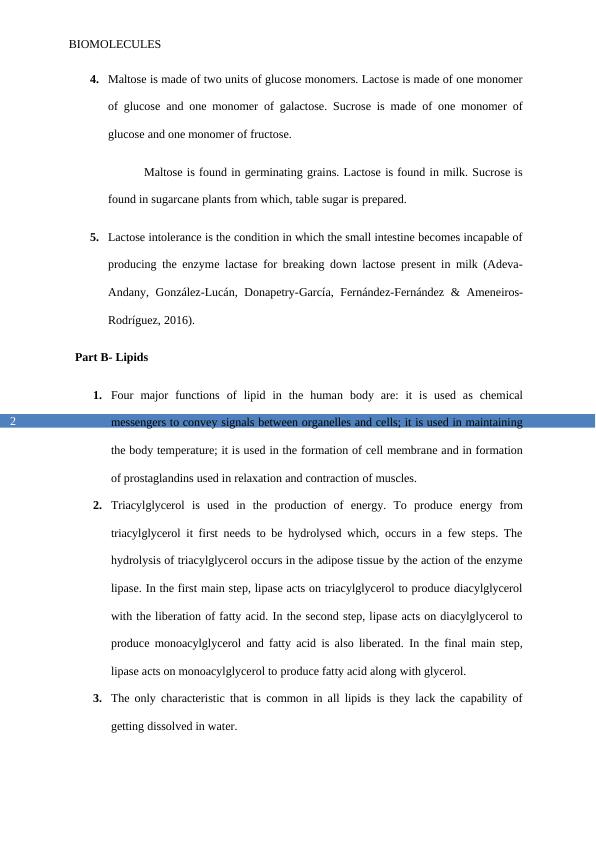Biomolecules | Carbohydrates, Lipids, and Proteins
Added on 2022-08-30
7 Pages1639 Words29 Views
Running head: BIOMOLECULES
BIOMOLECULES
Name of the Student
Name of the University
Author Note
BIOMOLECULES
Name of the Student
Name of the University
Author Note

BIOMOLECULES
1
Part A- Carbohydrates
1. The straight chain structure of glucose have functional groups including aldehyde
group attached on carbon 1 and alcohol groups attached on carbon 2 to carbon 6.
However, in the cyclic form, the functional group present in carbon 1 is hemiacetal
group. Glucose contains polar hydroxyl groups in abundance, which forms hydrogen
bond with molecules of water and thus is highly soluble in water.
Glucose is the primary source of energy that is required for the cells to
function properly and to support the metabolism of the body.
2. Glycogen is primarily work as the storage of glucose and providing it to the body
during starvation. It is present in abundance in liver and muscles.
Glycogen is a polysaccharide, which is made up of numerous glucose
monomers.
3. The chief anatomical differences between starch and cellulose are starch consists of
alpha glucose and cellulose is made of beta glucose. The starch molecule can form
both straight chains and helical structures whereas, cellulose can only form straight
chains. Functionally, human and animal as source of energy use starch whereas
exclusively plants for providing structural integrity use cellulose.
Human body can use starch as a source of energy as it is made of numerous
monomers of glucose and glucose is the unit of energy that can be used by the body to
function properly. Cellulose is not produced in the human body nor it can be digested
on consumption. On consumption, it comes out in the form of faeces and thus, it
cannot be considered as the source of energy.
1
Part A- Carbohydrates
1. The straight chain structure of glucose have functional groups including aldehyde
group attached on carbon 1 and alcohol groups attached on carbon 2 to carbon 6.
However, in the cyclic form, the functional group present in carbon 1 is hemiacetal
group. Glucose contains polar hydroxyl groups in abundance, which forms hydrogen
bond with molecules of water and thus is highly soluble in water.
Glucose is the primary source of energy that is required for the cells to
function properly and to support the metabolism of the body.
2. Glycogen is primarily work as the storage of glucose and providing it to the body
during starvation. It is present in abundance in liver and muscles.
Glycogen is a polysaccharide, which is made up of numerous glucose
monomers.
3. The chief anatomical differences between starch and cellulose are starch consists of
alpha glucose and cellulose is made of beta glucose. The starch molecule can form
both straight chains and helical structures whereas, cellulose can only form straight
chains. Functionally, human and animal as source of energy use starch whereas
exclusively plants for providing structural integrity use cellulose.
Human body can use starch as a source of energy as it is made of numerous
monomers of glucose and glucose is the unit of energy that can be used by the body to
function properly. Cellulose is not produced in the human body nor it can be digested
on consumption. On consumption, it comes out in the form of faeces and thus, it
cannot be considered as the source of energy.

BIOMOLECULES
2
4. Maltose is made of two units of glucose monomers. Lactose is made of one monomer
of glucose and one monomer of galactose. Sucrose is made of one monomer of
glucose and one monomer of fructose.
Maltose is found in germinating grains. Lactose is found in milk. Sucrose is
found in sugarcane plants from which, table sugar is prepared.
5. Lactose intolerance is the condition in which the small intestine becomes incapable of
producing the enzyme lactase for breaking down lactose present in milk (Adeva-
Andany, González-Lucán, Donapetry-García, Fernández-Fernández & Ameneiros-
Rodríguez, 2016).
Part B- Lipids
1. Four major functions of lipid in the human body are: it is used as chemical
messengers to convey signals between organelles and cells; it is used in maintaining
the body temperature; it is used in the formation of cell membrane and in formation
of prostaglandins used in relaxation and contraction of muscles.
2. Triacylglycerol is used in the production of energy. To produce energy from
triacylglycerol it first needs to be hydrolysed which, occurs in a few steps. The
hydrolysis of triacylglycerol occurs in the adipose tissue by the action of the enzyme
lipase. In the first main step, lipase acts on triacylglycerol to produce diacylglycerol
with the liberation of fatty acid. In the second step, lipase acts on diacylglycerol to
produce monoacylglycerol and fatty acid is also liberated. In the final main step,
lipase acts on monoacylglycerol to produce fatty acid along with glycerol.
3. The only characteristic that is common in all lipids is they lack the capability of
getting dissolved in water.
2
4. Maltose is made of two units of glucose monomers. Lactose is made of one monomer
of glucose and one monomer of galactose. Sucrose is made of one monomer of
glucose and one monomer of fructose.
Maltose is found in germinating grains. Lactose is found in milk. Sucrose is
found in sugarcane plants from which, table sugar is prepared.
5. Lactose intolerance is the condition in which the small intestine becomes incapable of
producing the enzyme lactase for breaking down lactose present in milk (Adeva-
Andany, González-Lucán, Donapetry-García, Fernández-Fernández & Ameneiros-
Rodríguez, 2016).
Part B- Lipids
1. Four major functions of lipid in the human body are: it is used as chemical
messengers to convey signals between organelles and cells; it is used in maintaining
the body temperature; it is used in the formation of cell membrane and in formation
of prostaglandins used in relaxation and contraction of muscles.
2. Triacylglycerol is used in the production of energy. To produce energy from
triacylglycerol it first needs to be hydrolysed which, occurs in a few steps. The
hydrolysis of triacylglycerol occurs in the adipose tissue by the action of the enzyme
lipase. In the first main step, lipase acts on triacylglycerol to produce diacylglycerol
with the liberation of fatty acid. In the second step, lipase acts on diacylglycerol to
produce monoacylglycerol and fatty acid is also liberated. In the final main step,
lipase acts on monoacylglycerol to produce fatty acid along with glycerol.
3. The only characteristic that is common in all lipids is they lack the capability of
getting dissolved in water.

End of preview
Want to access all the pages? Upload your documents or become a member.
Related Documents
Biomolecules: Carbohydrates, Lipids, Proteins, Nucleic Acidslg...
|5
|931
|280
STRUCTURE AND FUNCTION OF STARCHlg...
|3
|863
|59
The Role of Macronutrient Carbohydrateslg...
|7
|1587
|317
ISC 459 Analytical Processes Assignment 2022lg...
|7
|3025
|15
Biology Study Materiallg...
|9
|872
|56
Human Biology Study Materiallg...
|10
|2325
|59